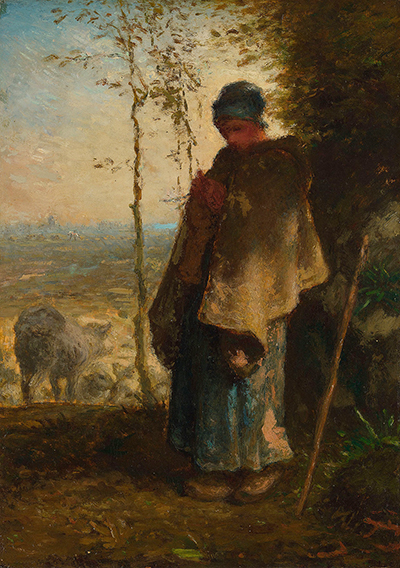Millet journey through art was unique. He grew up in a farming community, which explains why most of his paintings depicted rural settings. His paintings categorised him under realism, a form of art that related more to nature. La Petite Bergere (French for The Little Shepherdess), was one among many he did in this subject.
The Painting
It is an etching painting on a paper, drawn and commissioned in 1862. The painting showed a lady tending to a flock of sheep. She is standing in the shade, focusing on something on her hands. She seemed carried away, unaware of the sheep wandering away into the horizon. She has a matching blue gown and headgear, and a brown coat on.
Jean-François Millet did numerous paintings of the shepherdess theme. They include The Shepherdess Seated on the Rock (1856), The Knitting Shepherdess (1856 – 1858), Shepherdess with her Flock (1863), and The Young Shepherdess (1870 – 1873). His love for the farm is seen in other paintings such as The Woman Carrying Firewood and a Pail (1858 – 1860), The Sower (1865), Peasants Bringing Home a Calf Born in the Field (1864) and The Farm on the Hill (1867).
The painting exchanged possessions since its commissioning. The 1860 – 1870 decade saw most of Millet's painting, including La Petite Bergere, exhibited at the Salon. It was the official art showcase of the Academy of Arts in Paris. The painting moved to exhibit in numerous shows across France. Currently, it is at the Brooklyn Museum, New York City, in the United States.
Jean-François Millet Influence in the 19th Century
Millet did his pupillage at Bon Du Mouchel’s workshop, where he learnt portrait painting. His first paintings were portraits of various people. The proceeds he garnered from portraits enabled him to enrol at the Academy of Arts in Paris. He developed the love for landscape painting, rekindling the love for the farm. He grew into the art, occasionally taking up projects from establishments and prominent people in the society.
He nurtured many students and guided them across realism as a form of art. Vincent van Gogh was his notable student. Others include Claude Monet, Georges Seurat, and Salvador Dali, among others. His paintings are mostly found in the United States.; the Walter Art Museum, Princeton University Art Museum, Philadelphia Museum of Art, National Gallery of Art and the Boston Museum of Fine Arts. The ones in France are found at the Musee d’Orsay




